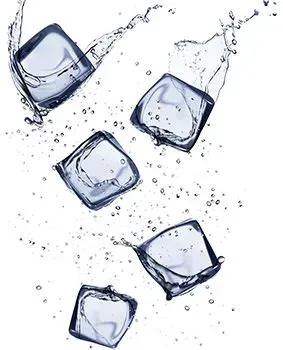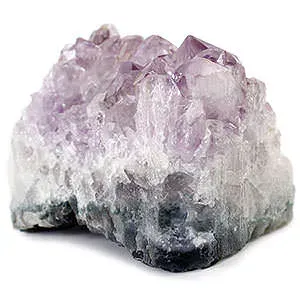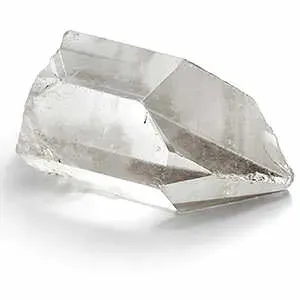 Quartz stones have been known, worked, carved, cut, used and worn in various settings since very ancient times and in almost every country. The name quartz may be derived from querkluftertz, an old German word referring to whitish vein quartz. The name has also been said to derive from the ancient Greek word krustallos, meaning, ice, because the Greeks (and the Romans) believed that quartz was ice that never melted because it was formed by the gods. The Sumerians cut and engraved various quartz stones as cylinder seals and used them later as ring seals. As the Sumerians invented writing, quartz was probably one of the first gemstones to be written on and also used as a stamp to make a written impression in clay. Thousands of years ago, the Egyptians made beads, scarab figures, and other jewelry from many of the quartz stones.
Quartz stones have been known, worked, carved, cut, used and worn in various settings since very ancient times and in almost every country. The name quartz may be derived from querkluftertz, an old German word referring to whitish vein quartz. The name has also been said to derive from the ancient Greek word krustallos, meaning, ice, because the Greeks (and the Romans) believed that quartz was ice that never melted because it was formed by the gods. The Sumerians cut and engraved various quartz stones as cylinder seals and used them later as ring seals. As the Sumerians invented writing, quartz was probably one of the first gemstones to be written on and also used as a stamp to make a written impression in clay. Thousands of years ago, the Egyptians made beads, scarab figures, and other jewelry from many of the quartz stones.
 Quartz is one of the most widely distributed minerals in the earth's crust and one of the most common minerals on earth. Because it is so abundant, it is also affordable. Quartz is the most versatile of any of the gem families. It includes more variety and a larger number of gems than any of the other three mineral families combined. Quartz offers a variety of color choices in both transparent and non-transparent varieties. Of the transparent types of quartz,
Quartz is one of the most widely distributed minerals in the earth's crust and one of the most common minerals on earth. Because it is so abundant, it is also affordable. Quartz is the most versatile of any of the gem families. It includes more variety and a larger number of gems than any of the other three mineral families combined. Quartz offers a variety of color choices in both transparent and non-transparent varieties. Of the transparent types of quartz, ![]() amethyst is the most valuable. Also in the transparent group is the absolutely clear rock quartz- the kind fortune tellers' crystal balls are made out of. Yellowish shades of quartz are called citrine. Brownish quartz is called smoky
amethyst is the most valuable. Also in the transparent group is the absolutely clear rock quartz- the kind fortune tellers' crystal balls are made out of. Yellowish shades of quartz are called citrine. Brownish quartz is called smoky ![]() topaz. Another variety of transparent quartz is called Ametrine, unusual bicolor quartz in which amethyst and citrine are both present in one stone. The name is derived from the first three letters of amethyst and the last five letter of citrine. Praseolite is a pale green variety of quartz, produced by heating amethyst. Rose Quartz is a light to dark pink variety, which was popular for many years in carved pieces such as beads, statues, ashtrays, lamp bases, and pins and brooches.
topaz. Another variety of transparent quartz is called Ametrine, unusual bicolor quartz in which amethyst and citrine are both present in one stone. The name is derived from the first three letters of amethyst and the last five letter of citrine. Praseolite is a pale green variety of quartz, produced by heating amethyst. Rose Quartz is a light to dark pink variety, which was popular for many years in carved pieces such as beads, statues, ashtrays, lamp bases, and pins and brooches.
 The translucent members of the quartz family are also quite extensive. Sardonyx was used for fine cameos that were cut during the Greek and Roman eras. Jasper occurs in green, yellow and blue. Agate and
The translucent members of the quartz family are also quite extensive. Sardonyx was used for fine cameos that were cut during the Greek and Roman eras. Jasper occurs in green, yellow and blue. Agate and ![]() chalcedony are found in all colors. Carnelian,
chalcedony are found in all colors. Carnelian, ![]() sard, and sardonyx are also member of the quartz family, and are reddish orange, apricot, and brown. Aventurine is pale to medium green with tiny sparkling flecks of mica within. Bloodstone is dark green with red spots or streaks. Chrysocolla is blue-green, chrysoprase is bright light to dark green, and tiger's eye is a golden yellowish variety of quartz. Agate and
sard, and sardonyx are also member of the quartz family, and are reddish orange, apricot, and brown. Aventurine is pale to medium green with tiny sparkling flecks of mica within. Bloodstone is dark green with red spots or streaks. Chrysocolla is blue-green, chrysoprase is bright light to dark green, and tiger's eye is a golden yellowish variety of quartz. Agate and ![]() onyx are also quartz stones.
onyx are also quartz stones.
 Quartz is quite a durable stone, rating an 8 on the hardness scale. Quartz vibrates at a steady rate in reaction to an electrical charge and synthetic quartz is used in watches to keep time. Quartz is formed in many different ways and occurs in many igneous and metamorphic rocks, particularly in granite and gneiss. Because it resists weathering, it is also found in alluvial sands and gravels. Quartz is extremely widespread. The most famous localities for magnificent large crystals are in the French Alps, the St. Gotthard massif in the Swiss Alps, the US, Brazil and Madagascar.
Quartz is quite a durable stone, rating an 8 on the hardness scale. Quartz vibrates at a steady rate in reaction to an electrical charge and synthetic quartz is used in watches to keep time. Quartz is formed in many different ways and occurs in many igneous and metamorphic rocks, particularly in granite and gneiss. Because it resists weathering, it is also found in alluvial sands and gravels. Quartz is extremely widespread. The most famous localities for magnificent large crystals are in the French Alps, the St. Gotthard massif in the Swiss Alps, the US, Brazil and Madagascar.